Diagonal lines are used by photographers to lead a viewer’s eyes to a particular spot in the composition. This spot is often the subject or very near the subject.
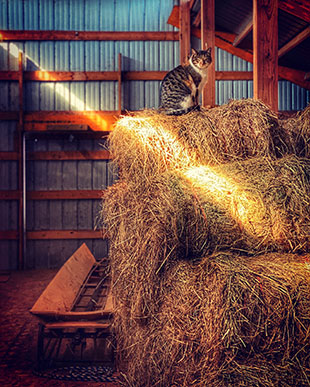
Photo by Kent DuFault
Create Visual Tension
Visual tension is created by a diagonal line. This tension is heightened when it intersects with other lines or other vital elements in the composition.
In some instances, a diagonal line works as a leading line and even as a pseudo-focal point.

Photo by Kent DuFault
There are two ways to get started with diagonal lines in your photography:
1. Focus your attention on spotting diagonal lines in a scene you wish to photograph.
2. Create the diagonal line to suit a particular composition or storytelling purpose.
Diagonal lines are super-efficient at moving a viewer’s eyes through a picture. When a diagonal line(s) intersects other objects in the composition, this creates point(s) of interest. These points of interest can become focal points.
In the photo above, the woman is almost completely obscured. However, the diagonal lines of the metal bars bring your eyes directly to her.
They then lead downward where they are abruptly cut off right at the woman’s hand, clutching her bag. This set of diagonal lines helps to create a story element.
Try a Dynamic Composition
When a composition has many diagonal lines, it’s called a Dynamic Composition.
The diagonals create visual excitement and are somewhat subconsciously unsettling as opposed to a static composition.
A static composition makes use of horizontal and vertical lines that imbue a sense of security and safety.
This photograph is a perfect example of dynamic composition. Do you notice how the diagonal lines lead right toward the subject? When they intersect and abruptly end at the robust vertical line, they create a focal point right next to the subject.
Critical Thought: Diagonal lines suggest a feeling of movement or direction. Objects presented in a diagonal line visually suggest instability in relationship to gravity. Since they’re neither vertical nor horizontal, your mind tends to imagine that something is moving or about to fall. This visualization creates tension and drama in a viewer.
Key Lesson: Diagonal lines can be a huge asset to your composition toolbox. You can look for diagonal lines in a scene or create them by tipping your camera. The key to successfully tilting the camera for diagonal line use is to learn when the effect is appropriate.
Tilt Your Camera
Diagonal lines were created with this American flag by merely tilting the camera.

Photo by Christopher Brown
Tilting your camera to capture diagonal lines is also known as the “Dutch Angle” or the “Dutch Tilt.” German Expressionist filmmakers first popularized this use of a camera.
In the example above, you can see how this technique creates drama with the diagonal lines. The viewer feels like something is about to happen.

Photo by Paul DuFour
Let’s use this photo of a building in Paris, France to show how the Dutch Angle can really take a photo’s viewer for a ride.
This shot was taken with the camera horizon properly and appropriately set. We have a building behind a hill.
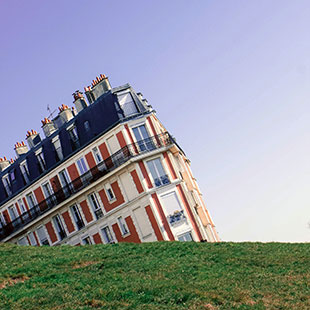
Photo by Pauline Loroy
In this photo, the photographer applied a Dutch Tilt, making the hill the horizon line and the building askew. This picture is so much more dynamic than the first version!
Where to look for diagonal lines or scenes to apply the Dutch Tilt:
- Architecture including roof lines
- Bridges
- Telephone and power line wires
- Staircases
- Canyons and rock formations
- Body Language
Remember: Any horizontal line viewed from the side becomes a diagonal line. Any vertical line viewed from above or below becomes a diagonal line. You may be able to create a diagonal line by only moving your camera position.
IDEA: Take a trip downtown and spend an afternoon photographing buildings. Look for naturally occurring diagonal lines, but also create some diagonal lines by tipping your camera.
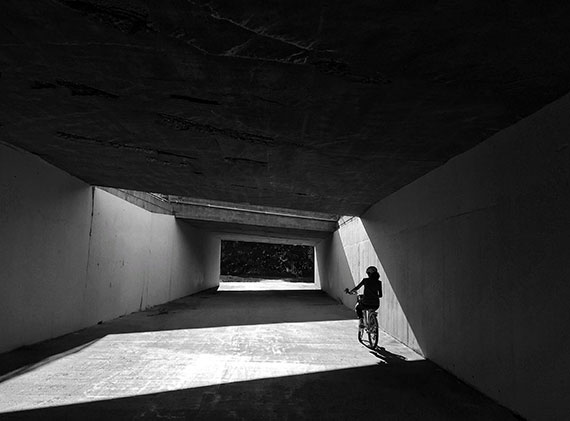
Photo by Kent DuFault
Another fantastic place to find naturally occurring diagonal lines is in the shadows!
Critical Thought: You can exaggerate diagonal lines using a wide-angle lens or in the positioning of your camera.
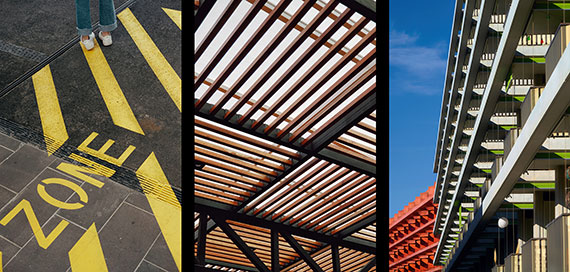
Left photo by David Clarke, center photo by Jorge Salvador, right photo by Ricardo Gomez Angel
Exaggerate Depth
By placing your camera closer to one end of the diagonal line, you can exaggerate depth perception.
Important Thought: You can start using diagonal lines with any camera, even your mobile phone camera. This technique requires no special tools. You simply need a keen awareness to this valuable composition tool.
Diagonal lines can create a depth perception of going into a picture. It can also create a feeling of going up or down.
Man & Staircase – This example of a ‘found’ scene uses two diagonal lines. The lines complete three tasks. They move the eyes toward the man. They help to create a direction in the photo from left to right. Finally, they create a visual tension that manifests itself at the point of the subject.
Use Body Language
No discussion of diagonal lines and dynamic composition would be complete without talking about body language.

Photo by Ben Weber
Take a look at the athlete photo above. This is a classic example of a diagonal line creating the visual effect of motion and direction in a still photograph.
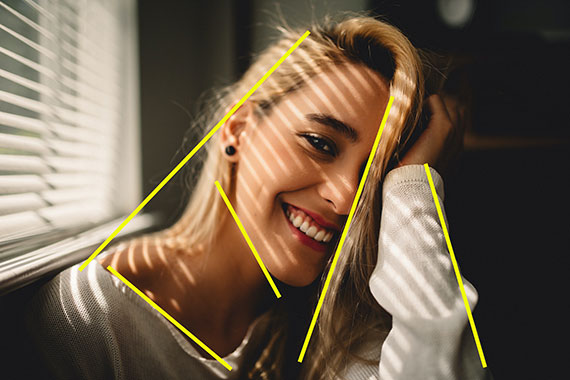
Photo by KAL VISUALS
This portrait displays the prominent diagonal highlight lines from the window blinds.
However, it’s the body language diagonal lines that give this image its oomph. The positioning of the head and hands create drama that focuses us on the young woman’s eyes and smile.
Remember these skill points as you practice learning how to use diagonal lines.
- Look into a scene with a specific eye toward spotting the diagonal lines.
- You can create a sense of motion and direction using a diagonal line, especially with body language.
- Try tilting your camera to create a diagonal line where one doesn’t exist.
- Using diagonal lines, you are creating a dynamic composition, which in turn helps give your photograph a mood and a sense of story.
As with this portrait of a woman, diagonal lines do not have to be physical objects. They can be created through light, shadow, or color. This photographer placed his subject near some diagonal lines to help set a mood for the resulting photograph.
Why don’t you give this a try?
- Organize a photoshoot using a model. Scout out several locations that you can use diagonal lines to set a variety of moods – peaceful, angry, excited, unhappy, busy.
- Go on a photoshoot where you seek diagonal lines existing in scenes, and then use them in a composition. Try twisting the camera POV to create diagonal lines.
- Print out your photos – study and share your results.
What do you think?
- Were you able to create different moods with your model and diagonal lines? What feelings did you capture? Share your results with others for opinions.
- Were you able to locate existing diagonal lines in a scene and use them?
- Did you create diagonal lines by tilting your camera? Do you feel that you achieved a more dynamic shot as a result?
- What was your favorite diagonal line technique?
- Can you see yourself using this in the future to create dynamic compositions for your photography?
About the Author:
Kent DuFault is an author and photographer with over 35 years of experience. He’s currently the director of content at the online photography school, Photzy.com
For Further Training, Deal Ending Soon:
This newly updated & expanded in-depth guide rolls years and years of practical knowledge, condensed into 239 pages packed with training, illustrations, and assignments. Advanced Composition goes far beyond knowing what composition is… (or, even knowing what the tools of composition are). Develop the SKILLS of anticipation, pre-visualization, and timing that are core to capturing great photography. It is currently 79% off for a limited time.
Broken into 84 key lessons, 38 assignments, & 117 self-check questions – it delves DEEP into the artistic and technical aspects of photographic composition. With this guide you will learn to SEE light, shadow, lines, curves, space, repetition, and focal points.
Deal ending soon: The Advanced Composition Guide at 79% Off
Like This Article?
Don't Miss The Next One!
Join over 100,000 photographers of all experience levels who receive our free photography tips and articles to stay current:











Leave a Reply